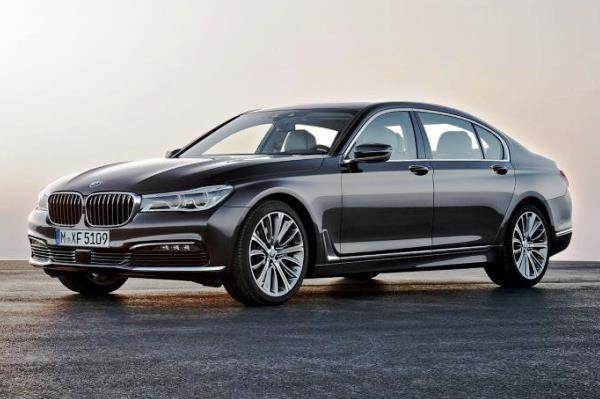The new BMW 7-series has been officially unveiled. Expected to go on sale internationally later this year, the carmaker’s flagship sedan has undergone considerable re-engineering, and the use of carbon-fibre reinforced plastic, high-strength steel and aluminium has helped it shed around 130kg over the current model.
Measuring 5,098mm in length, 1,902mm in width and 1,478mm in height, the new 7-series is 19mm longer and 7mm higher than its predecessor in the standard wheelbase guise; width remains the same. The long-wheelbase variant gains an added 139mm, making it 18mm longer than the car it replaces, at 5,238mm. Both the standard and long-wheelbase variants share the same wheelbase measurements as the old 7-series models, at 3,070mm and 3,210mm respectively.
The diesel engine, in the 730d, is a 261bhp 3.0-litre six-cylinder turbo diesel motor that allows it to go from 0-100kph in 5.8 seconds and reach a top speed of 250kph. The petrol is a new turbocharged 3.0-litre inline six-cylinder, which powers the 740Li. With 321bhp on tap, it has a 0-100kph sprint time of 5.5 seconds and a 250kph top speed. In the first half of 2016, BMW will provide the 7-series with a plug-in hybrid petrol-electric system in a new 740e model. Already employed in the X5 xDrive40e, it uses BMW’s new turbocharged 2.0-litre four-cylinder petrol engine and an electric motor mounted within the gearbox — a combined output of 321bhp, 0-100kph in 5.6 seconds and a 240kph top speed in hybrid mode. The twin-turbocharged 4.4-litre V8 petrol unit will be found in the 750i Xdrive internationally, next year. The engine delivers 444bhp, achieving a 0-100kph time of 4.4 seconds, and a 250kph top speed. A twin-turbo 6.0-litre V12 twin turbo is also set to join the 7-series range at a later stage. The V8 and the V12 are also set to be used by Rolls-Royce.
BMW is also looking at creating a new M7 or M750i M Performance version on the 7-series, that is likely to receive a heavily tuned version of the M5’s twin-turbo 4.4-litre V8 producing more than 600bhp.
All engines come as standard with an enhanced Drive Experience Control function, allowing the driver to choose between Comfort, Sport, Eco-Pro and a new adaptive mode that monitors driving style. As in other recent BMWs, the brake energy regeneration and automatic start-stop systems are complemented by a fuel-saving coasting function which decouples the engine on periods of trailing throttle at speeds between 50 and 160kph. All versions come with rear-wheel drive as standard. However, the optional four-wheel drive adds 70kg to the kerb weight.
The new 7-series rides on a heavily reworked suspension system. It now adopts air springs both at the front and rear, providing constantly variable damping control, automatic self-levelling and the ability to alter the nominal 135mm ride height on the go. The driver can raise ground clearance by 20mm using a button at speeds below 35kph. In Sport mode the ride height is automatically reduced by 10mm at certain speeds for improved aerodynamic efficiency.
The new car also comes with optional electro-hydraulically operated roll bars as part of the Executive Drive Pro function on all but the 740i and 740e. They replace the previous hydraulically operated roll bars, bringing what BMW describes as faster damper reaction time for improved ride comfort, a more progressive build-up of lean and reduced levels of body roll. As part of BMW’s weight-reducing effort, the wheel carriers, brake caliper housings, brake disc carriers and rear transverse suspension arms are all made of aluminium.
On the design front, there’s the revised bumper, kidney-shaped grille flanked by the LED headlights (laser headlights optional) and LED fog lights in the front. Along the flank there is a more pronounced shoulder, a taller glasshouse, and a chrome highlight runs along the lower edges of the doors. The rear has the high-set boot, tweaked bumper and the LED taillights are connected by a chrome strip.
The interior gets a newly designed dashboard, controls, updated digital instrument graphics that light up in either white, blue or red depending on the driving mode, a redesigned multi-function steering wheel and new front seats with ventilation and massage functions. There is also a Bowers and Wilkins surround-sound system, night vision, a glass roof that can be switched between six colours, and a head-up display with a larger screen than before.
Also on offer are new iDrive control functions including touch and gesture controls that allow the driver to deliver commands with a wave of the hand, and a remote parking system which uses a stereo camera mounted within the windscreen, and radar sensors to allow forward and reverse parking maneuvers at the press of a button.
The BMW 7-series will rival the likes of the Audi A8, Mercedes S-class and the Jaguar XJ. The India launch could happen sometime early 2016; expect India-specific details to trickle in leading up to it.



Comments
Member Login
Personal Details
No comments yet. Be the first to comment.